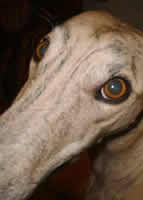Not all greyhounds want to be alone. And most of them don’t. They’ve been with siblings from the beginning, and then with hundreds of other hounds usually. So going from that environment to a home can be daunting for many of them. They need time, understanding, patience.
Best thing you can do for a hound with Separation Anxiety: Foster or Adopt another. This usually stops the SA.
A few tips:
– don’t leave blinds down. Let them see out the windows
– don’t lock them in a room. X-pens and baby gates are good alternatives.
– if they are chewers – muzzles are good to use (you can put something soft inside the muzzle over the nose area)
– I drape the ends of items which may get chewed with material/towels (tables/sofa arms etc)
– Azmira’s Abandonment can help. All natural.
– Toys, Kong with peanut butter
– Tons of exercise – a tired dog is a quiet, happy dog
– Dog walkers – whether you crate or not
– Don’t add to their anxiety with yours. Do calm, matter of fact leaving taking
– Drugs are NOT the answer
Dr. Karen Becker’s take on Separation Anxiety
From: Donna/Dominic D’Amico
One definition of separation anxiety is disruptive behavior that occurs when a dog is left alone as a distress response to separation from the person or persons to whom it is attached. Symptoms may include (but are not limited to):
- pre-departure anxiety—anxiety level rises as the owner prepares to leave (panting, pacing, trembling)
- refusal to eat (anorexic when owner is absent but will immediately eat upon their return)
- excessive salivation
- plaintive whining, barking or howling incessantly
- urinating or defecating indoors
- destruction of household property with tooth and nail (often harming themselves in the process)
- escape behaviors (dog may destroy doors, windows, surrounding woodwork, may dig under fences, jump over fences, open gates)
- exaggerated greeting behaviors
- continuously seek to maintain contact with owners (following them from room to room, leaning on them, lying in laps)
- will rarely spend time outside alone
The key to the diagnosis of separation anxiety is that the behavior only occurs during the absence of the owner. Absence can be as simple as a denial of access to the owner (i.e. closed door) or the owner actually leaving the premises. Some feel that separation anxiety results from a dog’s complete inability to cope with being left on it’s own which may stem from a lack of self-confidence on the dog’s part. Punishment has no place in the treatment of separation anxiety. In fact, punishment delivered by the owner may actually increase the dog’s separation anxiety by making the dog anxious about the owner’s return or departure. Anxiety behaviors are not the result of disobedience but are a distress response.
Dogs learn to associate specific activities with the impending departure of the owner (picking up keys, purse, briefcase, putting on shoes). The dog may exhibit pre-departure anxiety by pacing, panting or trembling. Severely afflicted dogs are often so strongly attached to a specific person or persons that the presence of any other living creature doesn’t matter. Separation related behaviors typically begin to occur within the first 30 minutes of the owner’s departure.
Mild or early-stage cases often respond well to common-sense changes in diet and exercise. A decrease in calories and protein content may help, as may an increase in exercise. Whenever possible, exercise the dog vigorously before leaving, but give him a chance to relax a bit before you actually go. Try to make your dog’s environment more entertaining by giving your dog a toy that comes out only when you leave. The purpose of this special toy is to distract the dog with something he will find interesting enough to not concentrate on your leaving. Suggestions include a Kong toy or other toy stuffed with food that will hold his attention for some time after you are gone. Some suggest leaving the TV or radio on while you are away, but this may be counter productive if the dog associates the TV or radio with a long absence.
Try withdrawing attention from the dog for 15 minutes before leaving and 15 minutes after returning to minimize exciting the dog. Avoid touching your dog on a constant basis. Vary your routine when coming and going from your home so that your dog doesn’t notice a pattern developing. Obedience training builds confidence as does agility training and may help a dog detach from its owner.
A good strategy for dealing with separation anxiety is to gradually get the dog use to being alone. Start with short departures where the dog has an excellent chance of not becoming anxious (may be seconds). Once the dog is comfortable with these short departures, gradually increase the time the dog is left alone. Increase these durations of absences very slowly and go back to shorter departures should the dog show even low levels of anxiety. Once you can safely leave the dog for a minute or two, increase the intervals of separation randomly so that the dog cannot learn to anticipate when you will return. Remember the goal is to gradually accustom the dog to being alone without become anxious.
If your dog suffers from separation anxiety, I encourage you to have your veterinarian recommend a behavior modification specialist. An appointment with a specialist could ultimately save their life and your sanity.
Separation anxiety can be a very complicated condition and to properly examine how to handle its various aspects takes far longer than any one email can handle. One of my Greyhounds, Midnite, suffers from extreme separation anxiety. Some things that I found particularly helpful in dealing with Midnite’s condition:
- “The Dog Who Loved Too Much” by Dr. Nicholas Dodman. A must read.
- More exercise.
- The services of a behavior modification specialist (veterinarian) for
help with behavior modification training.
